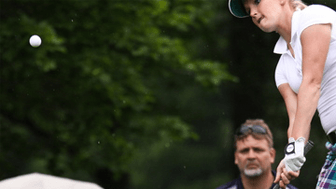
The majority of golf strokes occur near or on the putting green, but every day on the lesson tee I see players who have no concept of how to hit a basic short shot in golf, whether it’s a putt or a chip.
If you want to save shots and lower your score, here are some tips.
First, understand that a solid putting swing and a chipping swing are pretty much the same. So why is it that players often fear these short golf shots? The answer is that the cause of the issue is the breakdown (or collapse) of the left wrist in the hitting area.
I like to call the bottom of the golf swing the “impact zone.” When the left wrist bends or flips during the swing, the club head travels in an upward direction when it should move down and forward through the swing.
When I see great putters, I see absolutely no change in their wrist position. The left wrist is flat.
When I see great chippers, I notice a flat left wrist at impact and into the follow-through. This is a very important swing dynamic to work on. Some even refer to a flat wrist as a “secret.”
When I see a golfer with bent wrist action, I suggest they consider changing to a flat left wrist type stroke.
Start with your putter and position your left wrist on the golf grip so that your flat left wrist matches the flat club face. I have my students check this by holding the club perpendicular to the green and visually check the putter face alignment to their flat left wrist. If your grip in straight the two should line up.
Now, you are ready to roll a few putts. When putting, focus on your shoulders moving the arms and the flat wrist. The shaft and the left arm should form a straight vertical line.
Check this in front of a mirror or stand next to a wall and press your arm and club up against the wall. With this alignment you will feel a solid impact with the ball. Make sure the left wrist is flat.
Next, try it with a short iron. The chip swing is the same as a putt, but the set-up is different. What I recommend is to play the ball back in your stance, lean the shaft left so your hands are opposite your left leg, aim your feet left of the target (10-30 degrees), open your stance and keep your weight on the left foot.
Now, make a putting type swing with the flat left wrist. Notice that the club head stays low after impact and the left wrist is still flat. The divot or contact point with the turf is in front of the golf ball. The flat wrist ensures that you’ll make solid contact with the ball. Keep the shoulders, arms and club moving at the same pace. The flat wrist keeps this in line. This will help you control the distance and direction of your short shots.
This flat wrist is very important for golfers at any level. Pro golfers know this secret and practice it all the time. Next time you watch golf on TV, look for the flat wrist. Next time you see your local PGA Professional, ask him or her to help you develop this skill and show you some drills to practice. If you work on keeping the flat wrist through this impact zone, you will see great results.